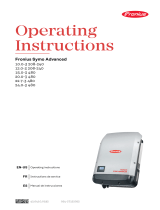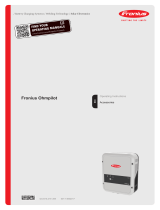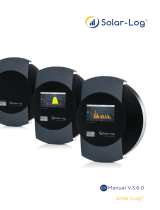Page is loading ...

08/2023 1/9
APPLICATION GUIDE
FRONIUS SNAPINVERTER
SA DYNAMIC EXPORT COMMISSIONING SETUP
Procedure as of 1st July 2023
Application Guide
© Fronius Australia Pty Ltd.
Version 2.0/2023
Fronius reserves all rights, in particular rights of reproduction, distribution and translation.
No part of this work may be reproduced in any way without the written consent of Fronius. It must not be saved, edited, reproduced or distributed using any
electrical or electronic system.
You are hereby reminded that the information published in this document, despite exercising the greatest of care in its preparation, is subject to change and that
neither the author nor Fronius can accept any legal liability.
Gender-specific wording refers equally to female and male form.

08/2023 2/9
1. CHANGE LOG
Date
Version
Comments
Author
02/07/2023
1.0
First release (Single Inverter sites only)
Fronius Australia
24/08/2023
2.0
Revised Solarweb setup and device registration
Fronius Australia
2. SCOPE
This document outlines the necessary commissioning procedure required to set up the SnapINverter series
inverters to operate under a SAPN Dynamic Export agreement as a part of the SA Smart Homes Scheme. The
commissioning steps outlined in this document are “additional” steps required on top of the standard inverter
commissioning process. Please consult our other documentation for information on how to perform the standard
commissioning steps.
IMPORTANT: This version 1.0 release of this document is ONLY valid for “single inverter” and “Inverter inbuilt”
communication sites. Multi-Inverter sites are not yet possible with the “inverter inbuilt / native” solution.
For multi-inverter sites an external 3rd party devices MUST be used instead. Multi-Inverter functionality will be
released in the coming months once available.
The following Fronius Inverter series are relevant to this document:
/ Fronius Primo SnapINverter series
/ Fronius Symo SnapINverter series
/ Fronius Eco SnapINverter series
For more information on the Dynamic Export Regulations installers are encouraged to visit the following
website:
https://www.energymining.sa.gov.au/industry/modern-energy/solar-batteries-and-smarter-homes/regulatory-
changes-for-smarter-homes/dynamic-export-limits-requirement
3. GENERAL INFORMATION & REQUIREMENTS
The SA Dynamic Export control function uses the IEEE 2030.5 based CSIP-AUS communication protocol to
communicate from a Utility Server (SAPN) to the Fronius Cloud Aggregator. The Utility Server publishes varying
“export limits’ which the Fronius Aggregator retrieves and forwards to the relevant inverter (Client). For
identification of the correct inverter, the protocol requires an LFDI (Long Form Device Identifier) to be
created/issued for the inverter to then be supplied to SAPN.
Compatible inverters are listed on the CEC Approved Inverter list and have an entry under the column:
“SOFTWARE CLIENT”.
https://www.cleanenergycouncil.org.au/industry/products/inverters/approved-inverters
All Fronius Australia CEC listed inverters are compliant to the SAPN Dynamic Export capable requirements.
To complete a compliant install, the system MUST have the following:
Fronius Smart Meter MUST be installed & commissioned in the system
Datamanager is loaded with a min. firmware version ≥ 3.27.1-3.
“Cloud Control” activated on the Datamanager WebUI
A PV System in Solarweb is active with the assigned inverter
Selected “Grid Operator” is “SA Power Networks”
“Only tick to register PV system for Dynamic/Flexible Export sites controlled by Fronius”
is ticked.

08/2023 3/9
NOTE: Due to the infancy of this emerging technology, there are steps in this guide that could change over
time. The user is therefore advised to always use the latest version posted on the Fronius Australia website.
.
4. SYSTEM INSTALLATION & COMMISSIONING
Carry out the installation & commissioning process as per the standard process, for more information please
consult with our online manuals: Datamanager Commissioning Guide
YouTube: https://www.youtube.com/watch?v=7G_pLLSl4UI
NOTE: After completion the Datamanager MUST be running the firmware version 3.27.1-3 or greater.
If the firmware is lower than 3.27.1-3, please update the Datamanager via the WebUI firmware update trigger
OR via Solarweb.
5. ONSITE INVERTER SETUP
5.1 Set pre-commissioning Export Limit
/ Go to “Settings”
NOTE: A “service” password should have already been set when commissioning the Fronius Smart Meter.

08/2023 4/9
/ Then go to “DNO Editor”
/ Scroll down to “Dynamic power reduction”
/ Set “Limit Entire System”
/ Enter the size of the PV array in W into the field “total DC power of the system”
/ Tick “Export Limiting Control (Soft Limit)”
/ Enter any value between 0 – 1000W in the field “Maximum Grid Feed-in Power”
/ Then click on the “tick” symbol to save

08/2023 5/9
NOTE: The Pre-Commissioning Export Limit is an additional fallback limit which the inverter maintains before
the Dynamic Export is in place. As soon as the inverter has communication to the SAPN Utility Server the
“local” export limit will be overridden.
5.2 Activate Cloud Control function
/ Scroll down to “Cloud Control” and tick “Allow cloud control for grid/utility compliance purposes”
/ Then click on the “tick” symbol to save
IMPORTANT: If the Cloud Control “Allow cloud control for grid/utility compliance purposes” is NOT
activated, the inverter will not be able to receive the export limit commands from SAPN.

08/2023 6/9
6. SOLAR.WEB CLOUD SETUP
6.1 Create system in Solar.web
Create a new system in Solar.web as per the standard process, see how to here:
https://www.youtube.com/watch?v=umE6-fTwRKA
6.2 Input correct site Address & Installation Date
For tracking of system performance, the correct site address and installation date of the system is entered
Ensure Installation date and address
details are matching the actual PV
system site address.

08/2023 7/9
6.3 Select & fill in Grid connection details
Under “Grid operator” choose “SA Power Networks”
Under “NMI – National Metering Identifier” enter site’s 11 x digit NMI number.
Tick the “Only tick to register PV system for Dynamic/Flexible Export sites controlled by Fronius” box
IMPORTANT: Ticking the “Only tick to register PV system for Dynamic/Flexible Export sites controlled
by Fronius.” box registers the inverter system with the SAPN Utility server and creates the LFDI in the
backgraound automatically. ONLY tick this box if the system is to be controlled by the Fronius cloud. i.e. Fronius
internal native solution.
DO NOT tick if controlled by Catch Relay, Zeco Marschall. The registration for these devices MUST be done by
them directly.
Also DO NOT tick this box for the SAPN Remote Disconnect functionality.
7. SAPN DEVICE REGISTRATION CHECK
7.1 Check “Device registration” in Smart Install
Access Smart Install and log in
Complete the required details and information up to “Device registration”
Check the “Device registration” tab for “Your device has been successfully registered”

08/2023 8/9
7.2 Run “Export Capability Test”
To run the “Export Capability Test” click on the “TEST EXPORT CAPABILITY” button.
Progress will be shown of each test being performed.
IMPORTANT: the system MUST be exporting at least 500W for the test to PASS. If the export is below 500W,
you will have to perform a test at another time OR turn loads off to enable the export to exceed 500W.
NOTE: this process can take up to 15mins depending on when the last data upload was executed.
When all GREEN ticks are present the test is finished and PASSED

08/2023 9/9
END OF DOCUMENT
Fronius Australia Technical Support
Email: pv[email protected]
Hotline: +61 3 8340 2910
To access Technical articles, Quick guides, Whitepapers and other technical documents, please visit the
Tech Support Area for Installers on our website
/







